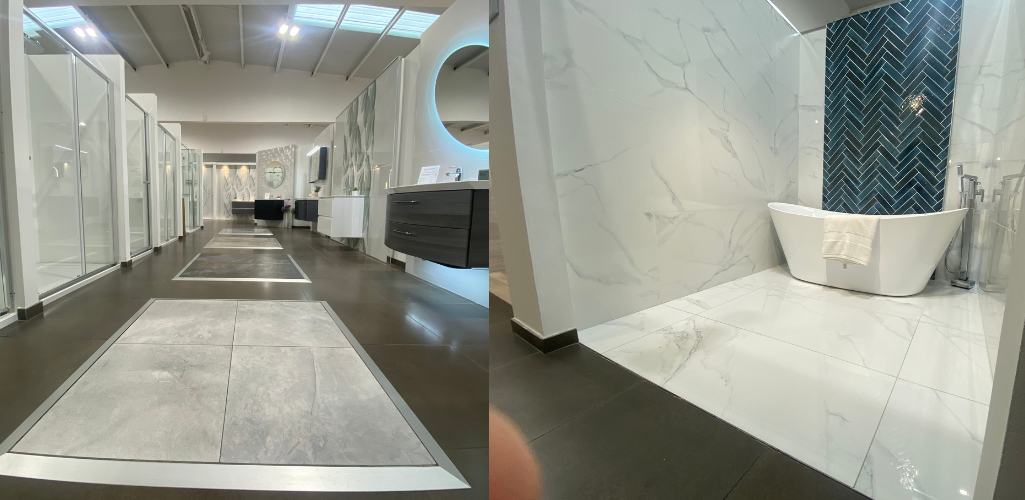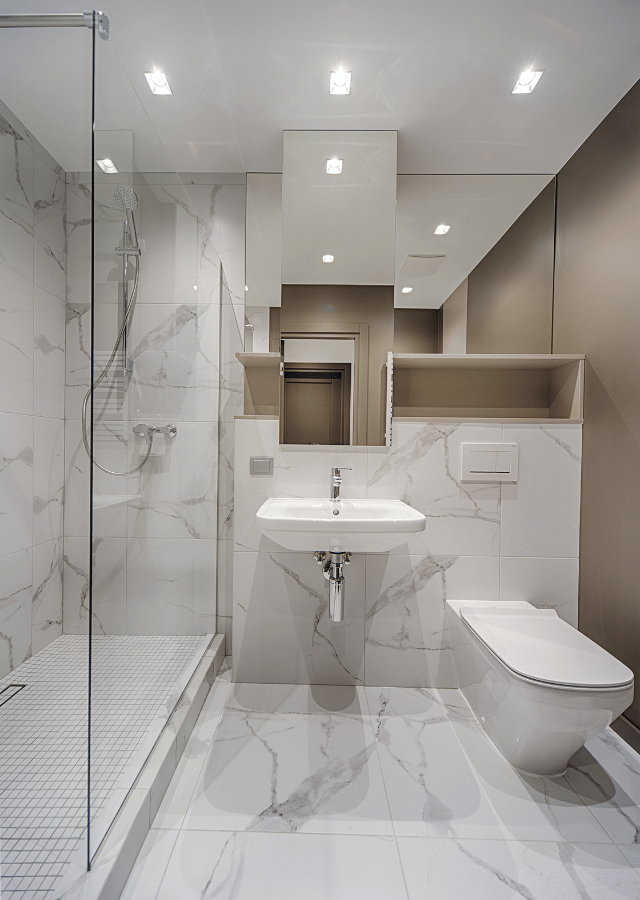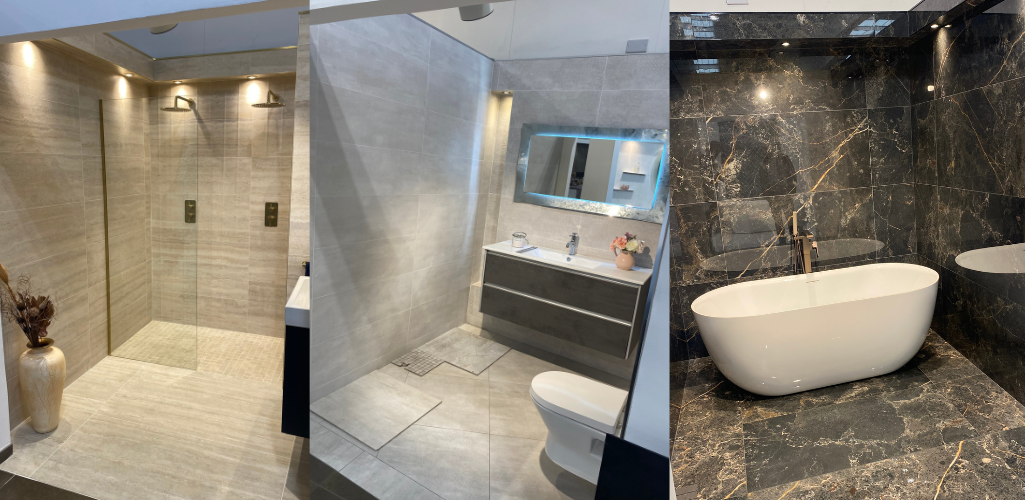To the untrained eye, tiles can look the same! But they are not always made the same.
That’s why knowing how to tell a porcelain tile from a ceramic tile is a useful bit of knowledge for all you homeowners.
It’s a question we get a lot at Ceramic City.
Porcelain and ceramic tiles offer diverse benefits, but their suitability varies depending on the situation.
In short, distinguishing porcelain from ceramic tiles is simpler than you might think. The key difference lies in their composition and water absorption rate.
Porcelain tiles are made from more refined clay and fired at higher temperatures, making them denser and less porous than ceramic tiles.
Keep reading to find out why.

What’s the Difference between a Porcelain Tile and a Ceramic Tile?
Porcelain Tiles Explained
Porcelain tiles are the most popular around now.
Known for their durability and low water absorption rates, thanks to being made from refined clay fired at high temperatures.
This process results in a tile that is dense and performs exceptionally well in high-moisture environments, which is why they are so suited to kitchens and bathrooms.
Read out Ultimate Guide to Porcelain Tiles here for more detail.
Ceramic Tiles Explained
Ceramic tiles, on the other hand, come in a wide range of designs and are known for versatility.
They are made from a mixture of clays and fired at a lower temperature than porcelain tiles, which makes them more porous.
Ideally suited for lower traffic areas within the home as they don’t offer the same durability as porcelain tiles.
A cheaper alternative to porcelain tiles, they are still really popular in homes.

How can you Identify if Tiles are Ceramic or Porcelain?
Visual and Inspection Methods
Identifying whether tiles are ceramic or porcelain can be achieved through a few simple methods.
Firstly, examine the tile’s density and weight; porcelain tiles are generally heavier and denser due to their composition and the high-temperature firing process.
Another reliable method is to look at the tile’s water absorption rate; porcelain tiles are designed to be highly water-resistant, with an absorption rate of less than 0.5%.
Lastly, the color and texture of the tile’s bisque (the body of the tile) can be a clue; porcelain tiles often have a color-through body, meaning the color remains consistent throughout the tile, whereas ceramic tiles may have a different color or design on the surface than the body.
Make sure to also look for any certification marks; authentic porcelain tiles may feature a Porcelain Tile Certification Agency (PTCA) certification mark.
Are Porcelain Tiles More Expensive than Ceramic Tiles?
Picking the Perfect Tile for Your Irish Home
Choosing the perfect tile relies on the particular requirements of your area.
If you’re looking for tiles that can withstand moisture or heavy use, porcelain tiles are the way to go.
When it comes to areas with less foot traffic, ceramic tiles provide a variety of design options at a more affordable price compared to porcelain.
We’ve got a great selection of Popular Wall Tiles in Ireland in this blog.

Conclusion
Ceramic City has an incredible range of porcelain and ceramic tiles for all budgets and styles.
Call in to any of our showrooms to have a look or check them out online.
If you still don’t know how to tell a porcelain tile from a ceramic tile, we can do that for you.
If you’ve any other questions, we’d be only delighted to answer them for you too.
Looking for premium quality porcelain and ceramic tiles in Ireland? Visit Ceramic City to explore our extensive collection and find the perfect tiles to enhance your home today.

FAQs about Porcelain and Ceramic Tiles
Is there a quick way to distinguish between porcelain and ceramic tiles?
One efficient way is to examine the tile’s water absorption rate. Porcelain tiles have a lower rate of absorption because of their denser body, making them less likely to absorb moisture. Inspecting the certification mark can also be useful, as porcelain tiles frequently come with a certification from the Porcelain Tile Certification Agency (PTCA).
Do porcelain tiles have greater durability compared to ceramic tiles?
Yes, in general, porcelain tiles tend to be more durable than ceramic tiles. Porcelain tiles are crafted from finer clay and fired at elevated temperatures, resulting in increased durability against wear, tear, and moisture. Porcelain tiles are a great option for areas with high foot traffic and outdoor spaces.
What makes porcelain tiles pricier than ceramic tiles?
Porcelain tiles tend to be pricier because of the advanced manufacturing process involving superior materials and higher firing temperatures. Through this method, the tile becomes denser, more durable, and better able to withstand moisture and frost, which ultimately leads to a higher cost.
Are porcelain and ceramic tiles suitable for any room in the house?
Indeed, both types of tiles are versatile and can be used in different rooms throughout the house. Thanks to their excellent moisture resistance and durability, porcelain tiles are perfect for bathrooms, kitchens, and outdoor areas. When it comes to ceramic tiles, they are more suitable for areas with lighter foot traffic such as bedrooms and living rooms due to being more porous and less durable.
What are the differences in maintenance requirements between porcelain and ceramic tiles?
Porcelain tiles typically need less upkeep compared to ceramic tiles due to their low porosity and increased durability. These surfaces are resistant to staining and do not require sealing. Given the higher porosity of ceramic tiles, they may need to be sealed and could be more susceptible to staining, which means they will require regular cleaning and upkeep.
How challenging is it to install porcelain tiles in comparison to ceramic tiles?
Porcelain tiles present a higher level of difficulty during installation because of their density and hardness, resulting in more challenging cutting and drilling processes. It’s best to consider professional installation services for porcelain tiles. Working with ceramic tiles is a breeze due to their ease of cutting and handling, making them ideal for DIY installations.
We have a blog on how to tile a kitchen splashback, a step by step guide.
Do porcelain or ceramic tiles have the potential to boost home value?
Absolutely, both porcelain and ceramic tiles are great investments for your home. Porcelain tiles are renowned for their strength and visual charm, making them a valuable selling feature. Yet, the ultimate effect on home value also relies on the quality of installation and design decisions.
